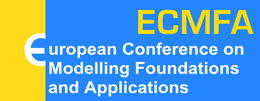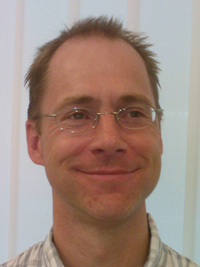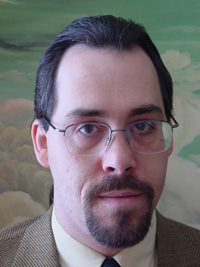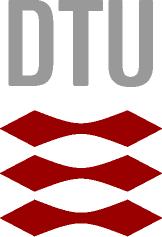8th European Conference on
July 2-5, 2012, Technical University of Denmark |
 |
Keynote speakers
We are happy that Henrik Lönn and Ed Seidewitz have accepted to be keynote speakers at ECMFA 2012. Their keynotes will be on July 4 and 5 during the main conference.
 Henrik Lönn, VOLVO Technology, Sweden:
Henrik Lönn, VOLVO Technology, Sweden:
Models Meeting Automotive Design Challenges
Wednesday, July 4, 915am, GlassalenThe slides of the presentation are available now
Abstract
Automotive systems are increasingly complex and critical. Their development account for a considerable share of the budget, both in terms of cost and time. The development process is complex, involving multiple development teams in varying disciplines, roles, departments, companies and locations, each using their own tools and notations.One contribution to meeting these challenges is to use a common ontology that integrates information according to recognized patterns, an Architecture Description Language. The purpose of EAST-ADL is to capture engineering information related to automotive electrical/electronic (E/E) system development, from early phase to final implementation. The system implementation is represented using AUTOSAR, i.e. EAST-ADL is complementary to AUTOSAR, adding information beyond the software architecture to serve engineering work already in early phases.
The EAST-ADL model has a core part representing the E/E system, which interfaces to an Environment model for near and far environment. Extensions for cross-cutting concerns or evolving modelling concepts annotate the core elements with these additional aspects. One of the Extensions concerns dependability and captures information related to safety. Another extension captures system timing using events, event chains and timing constraints.
The EAST-ADL system model is organized in 4 abstraction levels from the Vehicle Level’s abstract and solution-independent feature models over the Analysis Level’s hardware independent functional models and the Design Level’s hardware-allocated functional architecture to the Implementation Level AUTOSAR software and hardware architecture.
Based on an agreed modelling approach such as AUTOSAR and EAST-ADL, research and development on modelling technology, tools and methodology for automotive EE system development can continue more efficiently. Such results will allow the multitude of company specific approaches to be leveraged and gradually replaced by off-the shelf solutions.
About the speaker
Henrik Lönn has a PhD in Computer Engineering from Chalmers University of Technology, Sweden, with a research focus on communication issues in safety-critical real-time systems. Currently at Volvo Technology AB, he has worked with prototypes, architecture modelling and communication aspects on vehicle electronic systems. He is also participating in national and international research collaborations on embedded systems development. Previous project involvement includes X-by-Wire, FIT and EAST-EEA, ATESST and TIMMO. He is currently coordinating the MAENAD project.
 Ed Seidewitz, Model Driven Solutions, USA:
Ed Seidewitz, Model Driven Solutions, USA:
Executable UML: From multi-domain to multi-core
Thursday, July 5, 915am, Glassalen
Abstract
Modeling problem domains independently of technology domains is the basis for software that is adaptable to both changing business requirements and advancing technical platforms. Moreover, implementation-independent executable models allow problem-domain validation to be built right into agile conversations with customers. These validated models can then be compiled to a target implementation platform of choice.But, unlike traditional programming, executable modeling abstracts behavior from the problem domain, rather than abstracting from hardware computational paradigms. In particular, executable models naturally embrace concurrency, because problem domain behavior is concurrent. And, as we move into an era of multiple cores, dealing with concurrency is rapidly moving from a peripheral to a central issue in mainstream programming.
Our programming languages today, on the other hand, are too platform specific, still based too much on, and abstracting too little from, traditional sequential, von Neumann hardware architectures. What we need is a way to model problem domains that can then be compiled to the highly concurrent multi-core platforms around the corner as easily as the traditional platforms of yesterday. This is exactly what executable modeling offers.
Work over the last few years has now provided new standards for precise execution semantics for a subset of UML and an associated action language. Taking advantage of these new standards, executable UML holds out the promise of addressing some fundamental issues for the next generation of programming - from multi-domain to multi-core.
About the speaker
Ed Seidewitz is Vice President, Model Driven Architecture Services with Model Driven Solutions (MDS). In this position he leads all customer focused professional services business efforts, applying best-practice modeling, architecture and development methods. Prior to that, he held a number of positions leading both professional services and product development and delivery efforts. He has 25 years of professional experience with systems modeling, architecture and development, spanning diverse domains including aerospace, finance, acquisition and health care. In 2009, his 2003 paper "What Models Mean" was named an IEEE Software magazine 25th Anniversary Top Pick.Ed Seidewitz has also been active with the Object Management Group (OMG) for over 10 years, including involvement in every UML 2 Revision Task Force, as well as the Service Oriented Architecture Modeling Language (SoaML) and System Engineering Modeling Language (SysML) specifications. He was primary author of the recent Foundational Subset for Executable UML Models (fUML) and Action Language for Foundational UML (Alf) specifications. He is currently chair of the fUML 1.1 Revision Task Force and the Alf 1.0 Finalization Task Force, a leader of the Model Interchange Working Group and a member of the UML 2.5 Specification Simplification and UML Profile for the National Information Exchange Model submission teams.

